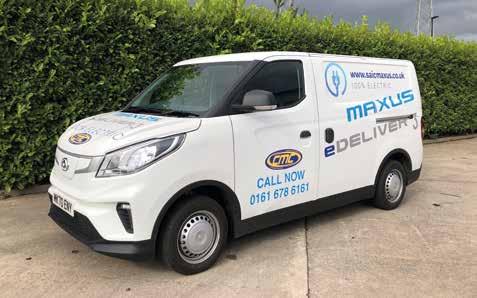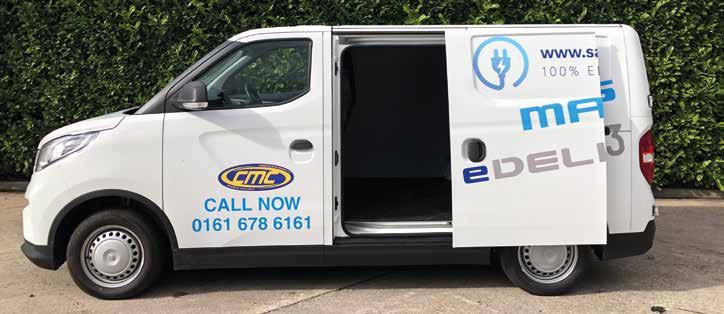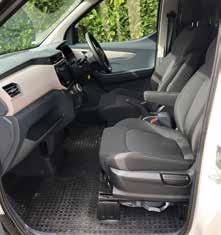
5 minute read
Maxus eDeliver 3
Maxus delivers the goods with a genuine all-electric contender
Andrew Walker gets to grips with the all-electric Maxus eDeliver 3 – and it’s got plenty to shout about
Advertisement
Thanks to Covid-19, you may have missed the news that LDV changed its name in April 2020 to Maxus. Maxus is owned by the Chinese SAIC corporation and is distributed in Europe by the Harris Group in Ireland. While Maxus is still making diesel vans – it recently launched a new large panel van, the Deliver 9 – it is in the electric van sector that it is ahead of the game.
First announced at the 2019 CV Show, the Maxus eDeliver 3 is the brand’s all-new medium- sized electric van. Where the Chinese came late to the combustion engine party, they were pretty much the first in with electric powertrains, as the larger LDV EV80 confirms.
From launch, customers can select either a SWB panel van or LWB version as a chassis cab, paired with the more powerful battery. Talking of which, there are two battery packs to choose from. A 35kWh battery, offering a city range of 141 miles and a combined range of 99 miles, and the larger 52.5kWh battery, which increases the city range to 213 miles and the combined to 151 miles. A rapid 45-minute DC charge with both batteries will top up to 80 per cent of range, while using the most common Type 2 AC charger with the 35kWh battery will take six hours; on the 52.5kWh battery this increases to eight hours.
Continued on page 26


Continued from page 25
Payload is competitive, whichever battery and style you choose. The 35kWh SWB van loads up to 865kg, while the sme wheelbase coupled with 52.5kWh battery takes this up to 905kg. The LWB chassis cab fitted with the larger 52.5kWh battery offers a 1,202kg payload, which isn’t too shabby at all.
The SWB van measures 4.55m long, with a 4.8m3 capacity. The maximum cargo space height is 1,330mm, maximum width is 1665mm andit measures 1,220mm between the wheel arches. The cargo length is 2,180mm in the SWB van. The access at the rear comes courtesy of a 60:40 split doors, which are 1.25m high and 1.25m wide. The side door is 710mm wide because of bulkhead intrusion, and 1,230mm high. Standard equipment includes arm rests, air con, SatNav, Apple CarPlay, Android Auto, twin USBs, Bluetooth, a driver’s airbag, reversing camera, rear parking sensors and cruise control.
While the exterior of eDeliver 3 bears an uncanny resemblance to the Nissan e-NV200, inside, it is more modern than the Nissan, with the dash-located touchscreen the highlight. The cabin build quality is okay, with some decent plastic on the dash and steering wheel, but it’s not as good as the quality you’ll find in the larger Maxus diesel Deliver 9. In comparison, it feels more modern inside than the interiors of the Nissan e-NV200 or Renault Kangoo, which are both beginning to show their age.
Up front there are two front seats, a flat-bottomed steering wheel, a drive mode selector dial, which frees up cabin space, and plenty of useful storage in the doors and between the front seats. There are two drinks holders, though note, the glove box is open.
I had the chance to test out the eDeliver 3 courtesy of Chadderton Motor Company, our local Maxus dealer. The model tested was the SWB 35kWh and from the off it’s incredibly easy to get to grips with and drive. There’s some decent speed, hitting 60mph in about eight seconds and top speed is 75 mph, which is more than adequate for the motorway.
Utilising the regeneration and the ECO button, we made our way around Manchester, driving approximately 30 miles but only using 20 miles of the stated range, which was good. ECO means your top speed is limited to around 65mph but if you switch it off, swifter progress can be made. The regeneration switch can be set to low, medium or high, dependent on what type of driving you are doing. Generally, motorway would be low, urban medium and city high regeneration.
On the motorway, at speed, the van did feel a little front heavy, especially when steering from lane to lane and when you’re in traffic, and there’s also some battery noise when you slow down which takes a bit of getting used to. The van panels are not the stiffest on sale and the rear doors don’t close with as much of a thud as we’d like. These, though, were our only criticisms. Overall, the ride is good, it generally handles well and the cabin is quiet. The on-board tech is easy to use and works well and it’s very well equipped.
If you’re still not sure about electric vans for your business because of range, it’s worth noting that the eDeliver 3 fitted with the larger battery offers the best range of any electric van. It’s also competitively priced, with an entry level cost of £36,000 including VAT, before the OLEV grant is taken into account.
Competition comes from the smaller Nissan e-NV200, which offers a payload of 705kg and a range of 124 miles, or the larger PSA group’s Citroen e-Dispatch, Vauxhall Vivaro-e and Peugeot e-Expert, which have payloads from 1,262kgs and a range of 143 miles on WLTP cycle. The Nissan e-NV200 starts at £31,468 and the Citroen e-Dispatch at £38,099 including VAT and before the OLEV grant.
With a name change and two new electric vans – the larger eDeliver 9 will arrive shortly – the future looks bright for Maxus, as the Chinese-owned company aims high. • Thanks to Neil Cadd at Chadderton Motor
Company for the loan of the eDeliver 3. Contact Neil on 0161 678 6161.

CC&V VERDICT
Competitive range, decent payload and excellent charging times means that the Deliver 3 is right on the button
CC&V RATING:
N N N N











